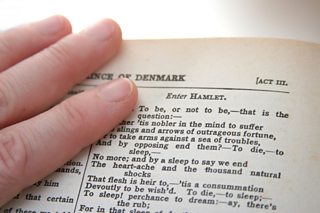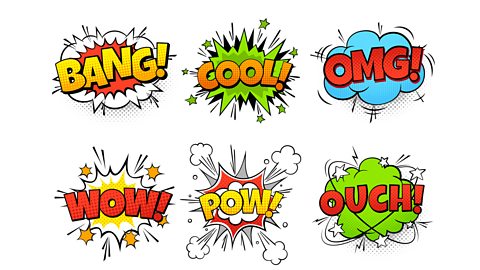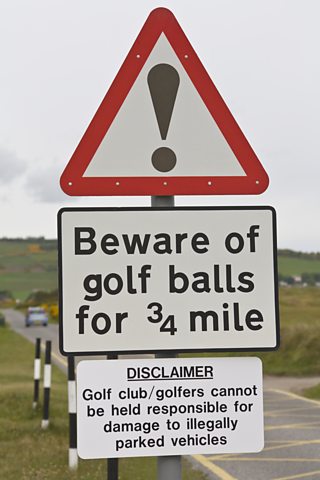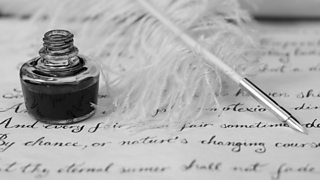Exclamation Marks!! Why do we love to hate them?
In a new series of Radio 4's Word of Mouth, Michael Rosen is joined by Dr Florence Hazrat to exclaim excitedly over exclamation marks.
The researcher and wordsmith was inspired to write An Admirable Point: A Brief History of the Exclamation Mark! after realising how much negative feeling surrounds this powerful piece of punctuation.
Florence explains how this little mark at the end of a sentence can flag up surprise, wonder, irony and more; how much it pervades our daily lives and why she doesn’t think it will be disappearing any time soon.
Listen to Word of Mouth: Exclamation Marks

Michael Rosen exclaims excitedly over exclamation marks with Dr Florence Hazrat, who has a passion for them. In Word of Mouth they explore the history behind the first symbol to indicate emotion.
The exclamation mark was invented in the 14th century
In the middle of the 14th century, Italian scholar Alpoleio da Urbisaglia wrote a treatise called The Art of Punctuating. “He was really annoyed that people would read sentences that are exclamations or show admiration or wonder in the same way that they also read statements or questions, and he thought he needed to do something about it,” says Florence. He suggested adding a dot at the end of the line, with a little apostrophe dangling above.
People were focusing on grammar and how to do things right in order to transmit an image of themselves as being someone who knows how to do something.
But it took another 50 years for this description of the exclamation mark to be realised on the page. Another scholar, called Coluccio Salutati, first put the exclamation mark in writing.
It was the first punctuation sign to express emotion
Punctuation that told the reader how to pronounce a sentence already existed in the form of the question mark. However, as well as directing us tonally (to give “more force” to our voice) the exclamation mark “also expresses feeling,” says Florence. This was a first.
“In the course of a couple of centuries, the exclamation mark just accrued more and more meaning,” says the author. As well as to give emphasis, or show wonder, it came to express all kinds of emotions.
The exclamation mark began to attract ill feeling in the 18th century
Initially, there wasn’t a lot of bad feeling surrounding the exclamation mark. There was a respect for those who could be “rhetorically savvy” and persuade and convince others. If it took exclamation marks to move readers, then so be it.
“The negative attitudes actually came later in the 18th and 19th and especially 20th centuries where people perhaps became a little bit suspicious of feeling in texts,” says Florence. “People were focusing on grammar and how to do things right in order to transmit an image of themselves as being someone who knows how to do something.”
F. Scott Fitzgerald described an exclamation mark as like “laughing at your own jokes”
More recently, the exclamation mark has been the subject of much derision. American author F. Scott Fitzgerald described its use as like “laughing at your own jokes.” In his Discworld novels, Terry Pratchett’s characters say the use of multiple exclamation marks is a sure sign of an “insane mind” and someone who “wears his underpants on his head.”

We certainly have a tendency to distrust the use of too many. Even Florence, a fan, admits that a tweet from a politician or official containing multiple exclamation marks evokes a similar gut reaction in her, because it’s so “flamboyantly claiming attention” and so capable of “riling us up.”
The exclamation mark in literature
The First Folio of Shakespeare’s works did use exclamation marks, particularly if a phrase began with something like, “O Juliet.” But there are amazingly few in such a long collection. No one knows who made the decisions to include or emit them.
The Victorian poet Gerard Manley Hopkins explores the glory of God and creation in his poetry, and uses the exclamation mark to express wonder and admiration. It also helps the author’s physical presence to be felt, says Florence. “I think the exclamation mark is doing a lot of work in terms of encoding that presence and that body and that physicality in the poem.”
The great literary users of exclamation marks came in the 20th century. Tom Wolfe’s novel The Bonfire of the Vanities is full of them. “He talks about extremes of wealth and glamorous 1980s New York, which seems to somehow call for exclamations,” says Florence. Salmon Rushdie is another author to embrace the exclamation mark. It makes sense in Magical Realism, says Florence, where “things are bombastic anyway.”
Exclamation marks feature prominently in comics

Zap! Pow!
Understanding the power of the exclamation mark in cartoon and comic art.
In comics, exclamation marks are often used to denote the end of a sentence, when a full-stop might be missed, says Florence. Sounds in comics, like “kapow” and “argh”, will almost always be followed by one, and often three.
“I think there is something about the shape that creates a punching power,” says Florence. The full stop at the bottom and the vertical stroke at the top “does something to our eyes, to our brains, to our body that just creates this punch.”
The exclamation mark is used as a warning
On a sign, the exclamation mark acts as a warning. “It tells us pay attention here, careful, there might be some traffic,” says Florence.

A 2013 study showed that people who had exclamation marks flash up in front of their eyes before being posed with an ethical question were then stricter with the response they gave. “Parts of the brain flared up that had to do with judgement and with alertness,” says Florence. The exclamation mark doesn’t make us “freak out” or “panic” but it’s the stage before that: “It somehow piques us and it makes up sit up and perk up.”
Exclamations are used differently around the world
Americans seem to exclaim more than the Brits – in fact three times as much. A hypothesis tested and found to be true by a linguist at Sussex University.
The Spanish don’t wait to the end of the sentence to insert an exclamation mark. They have an inverted one at the beginning too, to give the reader a heads up about the tone of the sentence to follow. ¡Clever!
We are more likely to use an exclamation mark on social media
Because social media is just that – social – we can be more relaxed and conversational than in other settings. “We can be playful. It’s less serious than a letter or work email,” says Florence. “When we are relaxed, we are more likely to use more exclamation marks because they are so bubbly.”
Phone technology also encourages the use of exclamation marks. “With our smart phones now it’s very easy to create any kind of sign… You just have to put your thumb down on it,” she says. “If something is easy to make, people are likely to make it.”
The exclamation mark is under threat from emojis
Although our phones make it easy to use punctuation, they also make it more redundant.
“Punctuation’s future is a little bit in danger nowadays,” says Florence. “Through our different kinds of technologies, we do away with the full stop. We don’t need it anymore.” We also now have emojis to signify particular feelings.
On the other hand, emojis have become very complicated and that’s actually counterproductive for the medium of texting, which is fast and mimics “real-time talk”. To have to decode emojis can take up valuable seconds.
“So, I think the exclamation mark will stick around,” says the author.

A world of words on Radio 4
-
![]()
Word of Mouth
Series exploring the world of words and the ways in which we use them, with Michael Rosen.
-
![]()
Dropping the mic and jumping the shark
Michael Rosen and Gareth Carrol, author of Jumping Sharks and Dropping Mics, discuss modern idioms and where they come from.
-
![]()
Coinages that changed the world – and some that tried to...
Exploring the hidden histories of obscure words, and common buzz phrases.
-
![]()
Ittibitium, borborygmus, and Ba humbugi – 14 wonderful science words you’ve never heard of
Michael Rosen puts the language of science under the microscope.




